
Assyria was a major ancient Mesopotamian civilization which existed as a city-state from the 21st century BC to the 14th century BC, then to a territorial state, and eventually an empire from the 14th century BC to the 7th century BC.

Chaldea was a small country that existed between the late 10th or early 9th and mid-6th centuries BC, after which the country and its people were absorbed and assimilated into the indigenous population of Babylonia. Semitic-speaking, it was located in the marshy land of the far southeastern corner of Mesopotamia and briefly came to rule Babylon. The Hebrew Bible uses the term כשדים (Kaśdim) and this is translated as Chaldaeans in the Greek Old Testament, although there is some dispute as to whether Kasdim in fact means Chaldean or refers to the south Mesopotamian Kaldu.
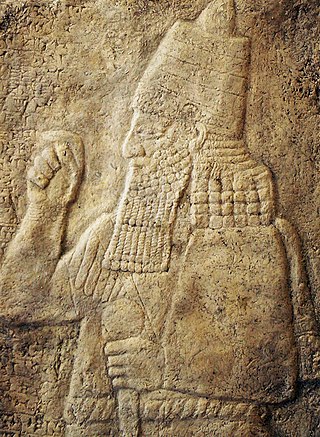
Sennacherib was the king of the Neo-Assyrian Empire from the death of his father Sargon II in 705 BC to his own death in 681 BC. The second king of the Sargonid dynasty, Sennacherib is one of the most famous Assyrian kings for the role he plays in the Hebrew Bible, which describes his campaign in the Levant. Other events of his reign include his destruction of the city of Babylon in 689 BC and his renovation and expansion of the last great Assyrian capital, Nineveh.

Marduk is a god from ancient Mesopotamia and patron deity of the city of Babylon who eventually rose to power in the First Millennium BC. In the city of Babylon, Marduk was worshipped in the temple Esagila. His symbol is the spade and he is associated with the Mušḫuššu.

Shalmaneser III was king of the Neo-Assyrian Empire from the death of his father Ashurnasirpal II in 859 BC to his own death in 824 BC.
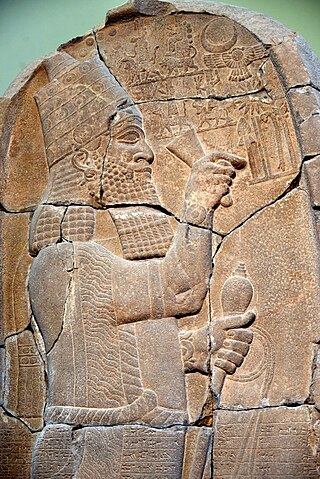
Esarhaddon, also spelled Essarhaddon, Assarhaddon and Ashurhaddon was the king of the Neo-Assyrian Empire from the death of his father Sennacherib in 681 BC to his own death in 669. The third king of the Sargonid dynasty, Esarhaddon is most famous for his conquest of Egypt in 671 BC, which made his empire the largest the world had ever seen, and for his reconstruction of Babylon, which had been destroyed by his father.
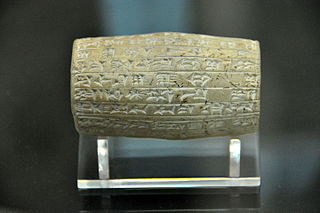
Nabopolassar was the founder and first king of the Neo-Babylonian Empire, ruling from his coronation as king of Babylon in 626 BC to his death in 605 BC. Though initially only aimed at restoring and securing the independence of Babylonia, Nabopolassar's uprising against the Neo-Assyrian Empire, which had ruled Babylonia for more than a century, eventually led to the complete destruction of the Assyrian Empire and the rise of the Neo-Babylonian Empire in its place.
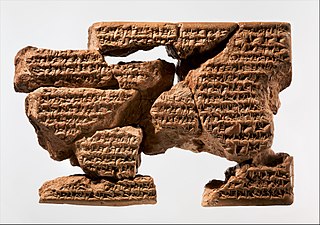
Sîn-šar-iškun was the penultimate king of Assyria, reigning from the death of his brother and predecessor Aššur-etil-ilāni in 627 BC to his own death at the Fall of Nineveh in 612 BC.
The Prophecy of Seventy Weeks is the narrative in chapter 9 of the Book of Daniel in which Daniel prays to God to act on behalf of his people and city, and receives a detailed but cryptic prophecy of "seventy weeks" by the angel Gabriel. The prophecy has been the subject of "intense exegetical activity" since the Second Temple period. James Alan Montgomery referred to the history of this prophecy's interpretation as the "dismal swamp" of critical exegesis.
Bible prophecy or biblical prophecy comprises the passages of the Bible that are claimed to reflect communications from God to humans through prophets. Christians usually consider the biblical prophets to have received revelations from God.

"Abomination of desolation" is a phrase from the Book of Daniel describing the pagan sacrifices with which the 2nd century BC Greek king Antiochus IV Epiphanes replaced the twice-daily offering in the Jewish temple, or alternatively the altar on which such offerings were made.

Nebuchadnezzar I, reigned c. 1121–1100 BC, was the fourth king of the Second Dynasty of Isin and Fourth Dynasty of Babylon. He ruled for 22 years according to the Babylonian King List C, and was the most prominent monarch of this dynasty. He is best known for his victory over Elam and the recovery of the cultic idol of Marduk.
Aššūr-bēl-kala, inscribed maš-šur-EN-ka-la and meaning “Aššur is lord of all,” was the king of Assyria 1074/3–1056 BC, the 89th to appear on the Assyrian Kinglist. He was the son of Tukultī-apil-Ešarra I, succeeded his brother Ašarēd-apil-Ekur who had briefly preceded him, and he ruled for 18 years He was the last king of the Middle Assyrian Empire, and his later reign was preoccupied with a revolution against his rule led by one Tukulti-Mer, which, by the end of his reign, allowed hordes of Arameans to press in on Assyria's western borders. He is perhaps best known for his zoological collection.

The Neo-Babylonian Empire or Second Babylonian Empire, historically known as the Chaldean Empire, was the last polity ruled by monarchs native to Mesopotamia. Beginning with the coronation of Nabopolassar as the King of Babylon in 626 BC and being firmly established through the fall of the Assyrian Empire in 612 BC, the Neo-Babylonian Empire was conquered by the Achaemenid Persian Empire in 539 BC, marking the collapse of the Chaldean dynasty less than a century after its founding.
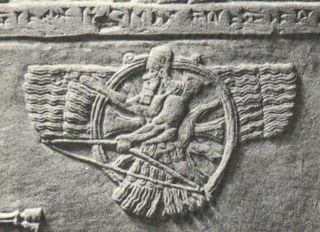
Ashur, Ashshur, also spelled Ašur, Aššur was the national god of the Assyrians in ancient times until their gradual conversion to Christianity between the 1st and 5th centuries AD.
Chapters 10, 11, and 12 in the Book of Daniel make up Daniel's final vision, describing a series of conflicts between the unnamed "King of the North" and "King of the South" leading to the "time of the end", when Israel will be vindicated and the dead raised, some to everlasting life and some to shame and everlasting contempt.

Enlil-nādin-aḫe, “Enlil gives a brother,” or Enlil-šuma-uṣur, “Enlil protect the son,” depending on the reading of –MU-ŠEŠ, ca. 1157—1155 BC, was the 36th and final king of the Kassite or 3rd dynasty that had ruled over Babylon and the land known as Karduniash since perhaps around 1500 BC.

Marduk-šāpik-zēri, inscribed in cuneiform dAMAR.UTU-DUB-NUMUN or phonetically -ša-pi-ik-ze-ri, and meaning “Marduk (is) the outpourer of seed”, reigned c. 1077–1065 BC, was the 7th king of the 2nd dynasty of Isin and 4th dynasty of Babylon and he ruled for thirteen years. His relationship with his predecessor, Marduk-nādin-aḫḫē is uncertain. His reign overlapped that of the Assyrian king Aššur-bēl-kala and his immediate predecessor(s) as the Synchronistic King List places him alongside both Tukultī-apil-Ešarra and Aššur-bēl-kala.
Marduk-zer-X was the 10th and penultimate king of the 2nd Dynasty of Isin, the 4th Dynasty of Babylon. The last part of his name is unknown, as the principal sources of information, the King List A and the Synchronistic King List are both damaged at this place in the sequence, hence the “x”. The reading of “zer” in his name by Poebel is almost as uncertain, as the character may be MU which would correspond to šuma or similar. His Assyrian contemporary was Aššur-nasir-apli I.

Akkadian or Mesopotamian royal titulary refers to the royal titles and epithets assumed by monarchs in Ancient Mesopotamia from the Akkadian period to the fall of the Neo-Babylonian Empire, with some scant usage in the later Achaemenid and Seleucid periods. The titles and the order they were presented in varied from king to king, with similarities between kings usually being because of a king's explicit choice to align himself with a predecessor. Some titles, like the Akkadian šar kibrāt erbetti and šar kiššatim and the Neo-Sumerian šar māt Šumeri u Akkadi would remain in use for more than a thousand years through several different empires and others were only used by a single king.














